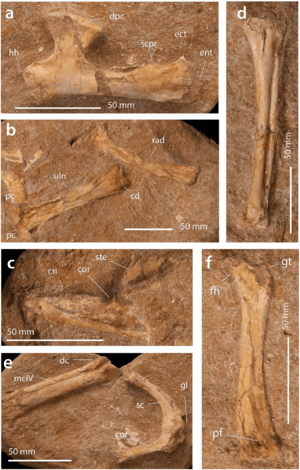Alcione facts for kids
Quick facts for kids AlcioneTemporal range: Upper Maastrichtian
|
|
|---|---|
 |
|
| A, humerus of holotype; B, radius and ulna of holotype; C, sternum of holotype; D, referred metacarpal IV; E, metacarpal IV and scapulocoracoid of holotype; F, femur of holotype. | |
| Scientific classification | |
| Genus: |
Alcione
|
| Species: |
elainus
|
Alcione was an extinct type of flying reptile known as a pterosaur. It lived during the very end of the Cretaceous Period, about 66 to 72 million years ago. Scientists found its fossils in rocks from the Ouled Abdoun Basin in Morocco, a country in North Africa. Alcione is part of a group of pterosaurs called nyctosaurids. It was one of several new pterosaurs discovered and described in 2018.
Contents
What Was Alcione?
Alcione was a genus of pterosaur. Pterosaurs were not dinosaurs, but they lived at the same time. They were the first vertebrates to develop powered flight. This means they could fly by flapping their wings.
A Flying Reptile
Alcione belonged to a family of pterosaurs called Nyctosauridae. These pterosaurs were known for their long, slender wings. They often had no teeth in their beaks. Many nyctosaurids also had large, bony crests on their heads. These crests might have been used for showing off or for helping them steer in the air.
Where and When It Lived
Alcione lived during the Maastrichtian age. This was the very last part of the Upper Cretaceous period. This time ended with a huge event that caused many animals, including most dinosaurs and pterosaurs, to die out. The fossils of Alcione were found in the Ouled Abdoun Basin. This area in Morocco is famous for its rich fossil beds. These beds contain many marine animals, showing it was once an ancient sea.
Discovery and Fossils
The discovery of Alcione helped scientists learn more about pterosaurs. It also gave clues about the ancient world.
Finding Alcione
Scientists found the fossils of Alcione in 2018. This discovery was part of a larger find in Morocco. Researchers found six new types of pterosaurs from the Maastrichtian age. Two of these pterosaurs are still waiting to be officially named. Finding so many new species in one place is very exciting for paleontologists. It helps them understand how diverse life was back then.
What Its Fossils Tell Us
The fossils of Alcione include parts of its skeleton. These parts help scientists figure out what it looked like. They can also guess how it flew and what it might have eaten. For example, the shape of its wing bones suggests it was a skilled flyer. Studying these fossils helps us piece together the puzzle of ancient life. It shows us how different creatures adapted to their environments.
See also
 In Spanish: Alcíone (desambiguación) para niños
In Spanish: Alcíone (desambiguación) para niños

